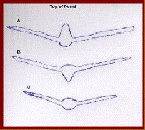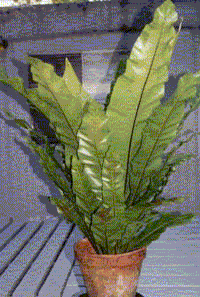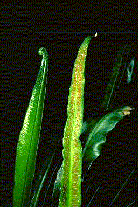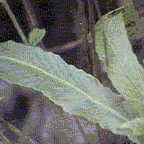|
| |
Bird's Nest
Fern
by Bob Halley,
Fern World
March 2001
|
When someone mentions
the bird's nest ferns, what do we think of? Probably Asplenium nidus, A.
australasicum, A. antiguum and, since last summer's sale, A. goudeyi.
Actually, there are many more species than that and this article provides
information about several of them.
First, I need to define
what I mean by a bird's-nest fern. I am going to take a very narrow view
and define them all as being Aspleniums with an erect rhizome, unbranched,
and forming a single growing tip. Their fronds (lamina) are simple and
form a regular rosette, usually upright, which makes a nest at the bottom
capable of holding litter in the form of leaves, bird droppings, etc. The
sori form long rows extending out from the midrib on the back of the outer
part of the lamina.
|
| One
of the distinguishing features of these ferns is the shape of the
cross-section of the midrib near the base of the frond. The
accompanying drawing of these shapes is taken, with thanks, from the
website of Keith Rogers of Mannum, South Australia at
http://www.lm.net.au/~kerogers/ . We will refer to this as we go
along. Notice that the three shapes are labelled A, B, and C. |
 |
 |
Let's
take a more careful look at the four prominent ferns mentioned
above. We will start with A. australasicum, which is by far the
most common in our local marketplace. This is a large fern with
fronds to about 60 inches long and 8 inches wide. The fronds
(lamina) are generally ovate and bright green, with tips being
either rounded or pointed. The midrib has shape 'b' and the
heavy 'keel' is easily felt. The sori are long and occupy at
least half the distance from the midrib. This fern is native to
Queensland and New South Wales in Australia, Norfolk Island,
Lord Howe Island, New Guinea, New Caledonia, Fiji, Samoa, Tonga
and Tahiti. It is somewhat cold tolerant so it grows here
beautifully. In U.S. markets it almost invariably sold as
Asplenium nidus, which it is not. I do not know of a true A.
nidus in cultivation locally. A. australasicum is nearly always
epiphytic, growing on the limbs and trunk of trees but it will
occasionally be found on rocks or even in the ground when a
mature plant has fallen. There is a variety that has lobed
fronds and is known as A. australasicum ' Multilobum'. |
|
As epiphytes,
all of these bird's-nest ferns should be potted in a very coarse
mix with great drainage. They should be under-potted to prevent
accumulation of too much moisture although double-potting with the
outer pot filled with gravel or the like may be necessary to
provide a heavy enough base to support the large fronds. They
should be lightly fed at frequent intervals during the growing
season. They are very susceptible to snails and slugs and, in San
Diego, also to the Giant White Fly.
As explained
above, Asplenium nidus is the better known name locally. It is
very similar in appearance to A. australasicum but with decided
differences. For one, it is truly tropical and will not grow here
without the protection of a greenhouse. It is native to northern
Queensland in Australia, Christmas Island, east Africa and India.
It is, in effect, Old World pan-tropical. The sori extend outward
from the midrib but do not cover as much as half the distance to
the margin. The most immediately identifiable feature is the shape
of the midrib or cross-section that is as in 'a' in the figure
with the strong 'keel' on the upper side. If you should acquire on
of these plants and can give it the needed protection, you should
otherwise treat it as for A. australasicum. Interestingly, there
is a variety of A. nidus known as 'Plicatum' or more commonly as
the 'Lasagna Fern' which is capable of living here unprotected and
which may be found in the local marketplaces. It is much smaller
with fairly narrow fronds which are heavily convoluted and
pleated.
Asplenium
antiguum is smaller
that two above and does not form as tight a nest since the fronds
taper toward both ends. It has a maximum frond length of about 40
inches and has narrower lamina to perhaps 4 inches. It has about
the same hardiness range as A. australasicum but the cross-section
of the midrib is different from both of the others having the
shape shown in 'c' in the figure, i.e.; rounded both top and
bottom. There is a very popular and handsome cultivar of this
species that is produced by cloning at Santa Rosa Tropicals and is
known as A. antiguum 'Victoria'. This form is fairly small and has
many strongly ruffled laminae.
Since our
introduction of Asplenium goudeyi to the U.S. market last autumn,
we may consider it one of our basic bird's-nest ferns. It is
smaller than the big epiphytes and is more often epipetric than
epiphytic. It grows in fairly harsh conditions along the cliffs of
Lord Howe Island and enjoys a marine atmosphere. Its fronds are
stiff and greyish and fairly upright. It may be grown outdoors
here in the same manner as A. australasicum.
While
researching the information on these four species, I encountered a
number of other bird's-nest type ferns that are seldom found in
local cultivation, usually because they require special
conditions. The following list is by no means exhaustive.
Asplenium
cymbifolium. This tropical form from the Philippines, Indonesia, Borneo,
Samoa and New Guinea is seldom if ever seen here. It has arching
fronds that may be over a meter long and 10 inches wide. The frond
bases are broad and dilated so that the rosette may even hold
water. I have found no description of the midrib but it is
probably shape 'b'.
Asplenium
harmonii.
This native of south-eastern Queensland is not a true birds'nest
by my definition but is considered so by the Australians. It is
seldom epiphytic, growing usually on basaltic cliffs, and the
rhizome branches to form more than one growing point. The fronds
taper to a narrow stem at the base. This results in a very untidy
rosette that does not hold things well. Otherwise the plant is
like A. australasicum.
Asplenium
musifolium.
Most modern authors give this plant specific status although some
still list it as variety of A. nidus. The two are obviously very
similar but A. musifolium has wider fronds to 10 inches and is a
very dark green which A. nidus never is. Like A. nidus, this
requires a greenhouse locally.
Asplenium
phyllitidis.
This is native to Singapore and Malaysia. It is similar to A.
nidus (no mention of midrib) but has shorter and much narrower
fronds that narrow at the base and form a rather poor nest. It is
both epiphytic and epipetric and needs a very tropical
environment.
|
 |
Asplenium
simplicifrons.
This Australian native has long,
narrow strap-like fronds with lamina up to 2 feet long and
only about 2 inches wide. The midrib has shape 'b'. It is the
most common bird's-nest in northern Queensland. It should make
a good basket fern here if given even shade-house protection.
There is a form which is sometimes called A. laciniatum, which
is forked at the ends but this and also lobed forms occur
naturally in the species. |
| Asplenium
serratum.
This is the so-called American
Bird's-nest Fern but it is only superficially so. It is native
to the New-World tropics. It is epiphytic but, unlike the
others, it has heavy, proliferous roots so that it spreads
into many rosettes. It is like the A. nidus is appearance with
fronds over three feet long and up to 6 inches wide but they
are usually dull rather than bright green. The midrib is not
described. The margins of the lamina are usually coarsely
toothed. It would need protection to be grown here. |
 |
| References: |
|
| Goudey,
Christopher J. |
A
Handbook of Ferns for Australia and New Zealand |
| Hoshizaki,
Barbara Joe; |
Fern
Growers Manual |
| Jones,
David L.; |
Encyclopaedia
of Ferns |
| Piggott,
A.G. |
Ferns
of Malaysia in Colour |
| Mickel,
J.T. & Beitel, J. M. |
Pteridophyte
Flora of Oaxaca, Mexico |
| Flora
of Australia. Vol. 48. |
Ferns,
Gymnosperms and Allied Groups. |
| So,
M.L. |
Common
Ferns of the Phillippines |
| Jones,
David L. |
Fern
Society of Victoria 'Newsletter' Nov-Dec 1996.
Reprinted
from Muellaria Vol. 19, pp 37-40 |
|
